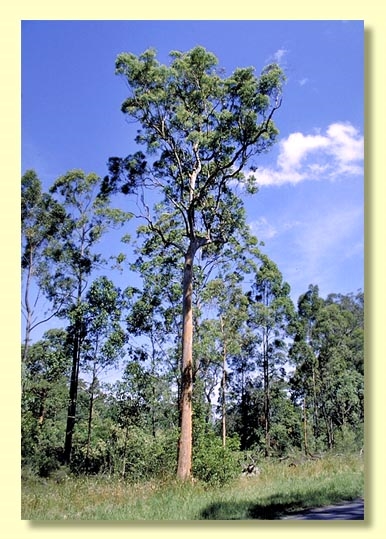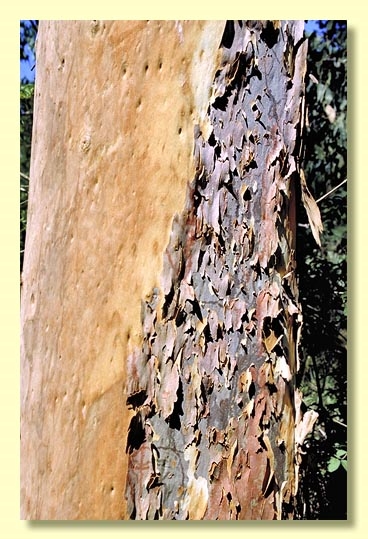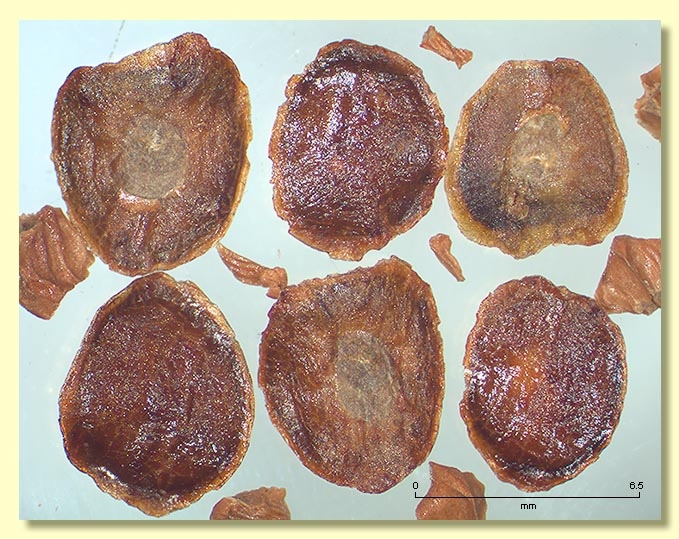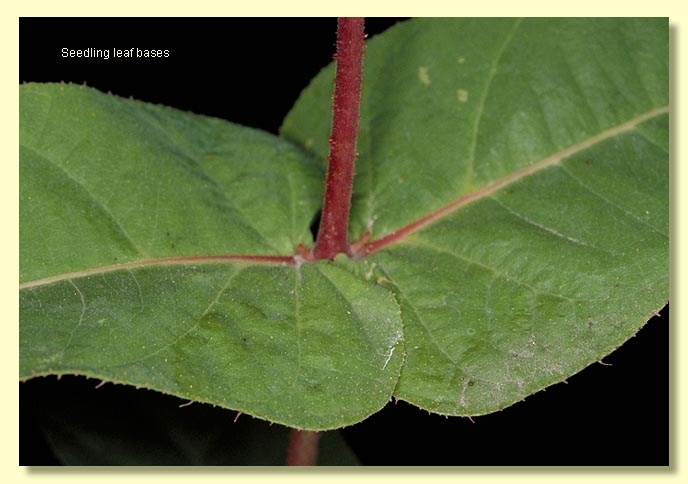Euclid - Online edition
Angophora costata subsp. costata
Angophora
Angophora costata (Gaertn.) Britten, J. Bot. 54: 62 (1916) subsp. costata.
Metrosideros costata Gaertn., Fruct. Sem. Pl. 1: 171 (1788). T: unknown.
Angophora lanceolata Cav., Icon 4: 22, t. 339 (1797), nom. illeg.; Metrosideros lanceolata (Cav.) Pers., Syn. Pl. 2: 25 (1806), nom. illeg. non Smith (1797).
Metrosideros apocynifolia Salisb., Prodr. Stirp. 351 (1796); Eucalyptus apocynifolia (Salisb.) Brooker, Austral. Sys. Bot. 13: 135 (2000). T: near Port Jackson, NSW, D.Burton s.n.; herbarium of cited specimen not known to us.
Melaleuca costata Raeusch., Nomencl. Bot. ed. 3: 142 (1797) nom. nud. fide DC. Prodr. 3: 222 (1828); also G.J.Leach, Telopea 2 (6) 757 (1986).
Metrosideros splendens Gaertn. ex DC., Prodr. 3: 222 (1828) nom. nud.
Angophora lanceolata var. hispida A.Cunn. ex A.Gray, U.S. Expl. Exped., Phan. 1: 555 (1854). T: 'Woollongong and near Sydney', NSW, collector unknown; holo: GH n.v., fide G.J.Leach, Telopea 2: 757 (1986).
Medium-sized to tall tree to 30 m high. Forming a lignotuber.
Bark smooth, pink to orange to dull pink-grey, weathering to grey. Glands (or ducts) sometimes present in the pith but only seen just below the nodes on young branchlets.
Juvenile growth (coppice or field seedlings to 50 cm): stem rounded in cross-section, smooth; juvenile leaves opposite, sessile, elliptical to ovate, 6–12.5 cm long, 2–6.5 cm wide, base amplexicaul, margin entire, apex acute, green, glabrous.
Adult leaves opposite, petioles 0.9–2.5 cm long; blade lanceolate or falcate, 7–19 cm long, 1.2–3.5 cm wide, flat, base tapering to petiole or rounded, margin entire, apex acute, discolorous, glossy green, penniveined, densely to very densely reticulate, intramarginal vein present, oil glands obscure or absent.
Inflorescence terminal compound, peduncles 0.3–2 cm long, buds 3, rarely 7 per umbel, pedicellate (pedicels 0.3–0.8 cm long). Mature buds globular (0.4–0.8 cm long, 0.5–0.7 cm wide), hypanthium glabrous (rarely pubescent), longitudinally ribbed, petals white with a green keel, stamens inflexed, anthers oblong, versatile, dehiscing by longitudinal slits (non-confluent), style long, stigma blunt, mop-like, locules 3 or 4, the placentae each with 5 vertical ovule rows. Flowers white or creamy white.
Fruit pedicellate (pedicels 0.2–1.2 cm long), barrel-shaped or cylindrical, 1.0–1.8 cm long, (0.7)0.9–1.7 cm wide, longitudinally ribbed, disc descending, valves 3 or 4, enclosed.
Seeds reddish brown to brown, 5–8 mm long, flattened-ellipsoidal, dorsal surface smooth, hilum ventral.
Cultivated seedlings (measured at ca node 10): cotyledons reniform to orbicular; stems rounded in cross-section, scabrid with bristle-glands and hairs; leaves opposite, sessile, lanceolate to oblong, 6–13 cm long, 2–5 cm wide, amplexicaul, margin entire or irregular, apex pointed, discolorous, green, scabrid.
Flowering has been recorded in October, November and December.
Angophora costata is a popular ornamental.
Angophora costata is the only species in a series diagnosed by the smooth bark and the distinctly petiolate adult leaves.
A. costata consists of three subspecies:
A. costata subsp. costata
Weakly distinguished from the other subspecies by the relatively small, ribbed fruit (usually less than 1.5 cm wide). It is a medium-sized to tall tree, mainly coastal from Bodalla and Narooma to Coffs Harbour and west to the Blue Mountains in New South Wales, with a large disjunction to the White Mountains near Pentland in northern Queensland. Scaly-barked trees at Red Rock on the north coast of New South Wales may belong to this subspecies.
A. costata subsp. euryphylla
Weakly distinguished from the other subspecies by the relatively large, ribbed fruit (usually greater than 1.5 cm wide). It is a small to medium-sized tree, restricted to sandstone outcrops in a small area between Putty and Wollombi and south along the Judge Dowling Range in New South Wales.
A. costata subsp. leiocarpa
Distinguished by the thin-walled, non-ribbed fruit, like those of ghost gums (Eucalyptus subgenus Blakella). It is a small to medium-sized tree occurring north from Grafton and Narrabri in north-eastern New South Wales, and is widely distributed in south-eastern Queensland north to Blackall and Mackay.
MORE ABOUT ANGOPHORA
subsp. euryphylla: Greek eurys, broad and phyllon, leaf.
subsp. leiocarpa: Greek leio, smooth and carpos, fruit.














